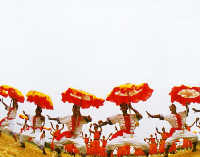The Chinese folk dances are a part of the Chinese traditional culture and the crystallization of their national wisdom with a long history, profound contents, diverse forms and rich colours. They have always been closely connected with the common people's ideas, labour and daily life in their evolution and development for thousands of years, thus formulating a strong connection with the people and faithfully reflecting their ideas and wishes, and accompanying their life journey.
Collection of Chinese Folk Dances, with Wu Xiaobang as its Editor-in-Chief, aims to record the folk dances of all ethnic groups and all regions all over China accurately, scientifically and completely, including not only their movements, music, floor patterns, costumes, and props, but also the spreading region, historical evolution, style and characteristics, relevant legend, historical account, introduction to the artists, production process, life style, as well as custom and habit, religious ritual of each dance. The volume of each province is compiled with the same layout, and consists of summaries of local folk dances of different ethnic groups, investigation tables, and representative dances, which are categorized and edited according to the ethnic divisions, The collection is composed of 30 volumes and amounts to over 42,130,000Chinese characterswith a lot of colourful and B & W illustrations.By 2000, 30 volumes of The Collection of Chinese Fofk Dances had been published.
 Festival and Seasonal Dances
Festival and Seasonal Dances
The most prominent feature of the Chinese folk dances is their folkloric character. To enable the readers to clearly understand these Chinese folk dances, we, according to the angle of folklore, have classified self-entertainment, sociality and choosing spouses, physical exercises and technical sports, dancing for a living, etc.; Festival and Seasonal Dances, Ritual Dances such as those happening at child-bearing rituals, adult rituals, weddings, birthday celebrations, funerals, sacrificial rituals, military practices, etc.; Belief Dances such as those done at the rituals of the Taoism,Buddhism, Islamism, primitive religions, spiritual belief activities among common folks; and Working-based Dances.
The Chinese folk dances have formed a complicated phenomenon of multi-function and multi-culture mixing with each other during their long spreading and evolutionary process, thus leading to a diverse situation. Therefore, the following dances are classifies according to their major characters for the purpose of exposing their cultural meanings more properly.
Shangdong Volume: Guzi Yangge
 It is widely popular in the Counties and the Cities of Shanghe, Huimin, Leling, Lingxian, Yangxin, Jiyang, and Linyi of Shangdong Province and performed at theSpring Festivalor some other important celebrations.There are four roles in Guzi Yangge: "Umbrella", "Drum", "Stick" and "Flower", and three of which are named after the props while the fourth refers to a female dancer. The movements of "Umbrella" are well-rounded, smooth, standing erect and fairly forceful; the movement of "Drum" are bold and imposing; the movements of "Stick" fast and lively, clean and clear, and the movements of "Flower" fiery and powerful, light-hearted and graceful.
It is widely popular in the Counties and the Cities of Shanghe, Huimin, Leling, Lingxian, Yangxin, Jiyang, and Linyi of Shangdong Province and performed at theSpring Festivalor some other important celebrations.There are four roles in Guzi Yangge: "Umbrella", "Drum", "Stick" and "Flower", and three of which are named after the props while the fourth refers to a female dancer. The movements of "Umbrella" are well-rounded, smooth, standing erect and fairly forceful; the movement of "Drum" are bold and imposing; the movements of "Stick" fast and lively, clean and clear, and the movements of "Flower" fiery and powerful, light-hearted and graceful.
The history of Guzi yangge can be traced back to as early as the Emperor Jiajing's Reign in theMing Dynastyfrom 1522 to 1566, according to the historical record.
Jilin Volume: Farmer's Dance
Farmer's Dance, popular in the congregating area of the Korean ethnic group in the northeastern China, is a representative dance favoured by these people. It is characterized by "beating tambourine" and "swingingelephant cap". The movements of tambourine beaters are rich and vigorous and posing like horse riders and arrow shooters while the elephant cap swingers use their necks as axles just to swing the 12-metre long tape tied to the cap, which move like wheels round the dancers and dazzle the viewers. The dancers usually consists of about 60 people, and hold a banner with the characters reading as "Agriculture is the basis of the whole world", which tells the aim of this particular dance as paying much attention to the agriculture as well as entertaining the farmers.
